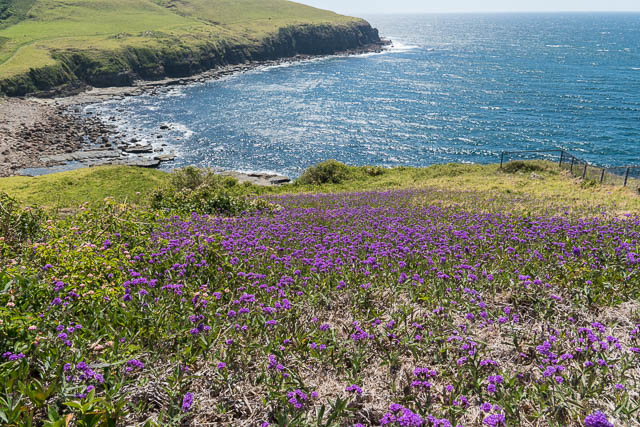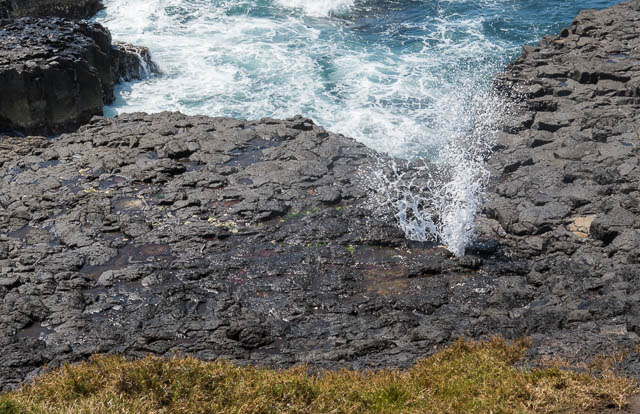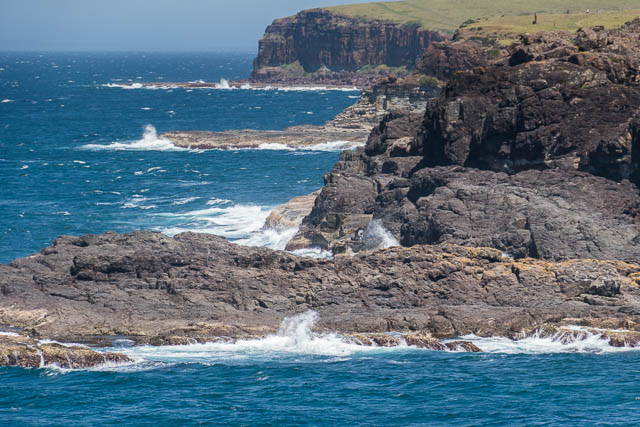The coast near Kiama is quite interesting – with some dramatic sea stacks, columnar basalt and blow holes. I heard online about the Kiama Coast Walk and was keen to explore it. The official walk goes from Minnamurra to Kiama and then continues south to Gerringong. It is possible to continue along to Geroa further to the south.

Three key places on the coast walkway are serviced by train – Minnamurra, Kiama and Gerringong. That makes it easy to plan trips. Also there are good resources online that provide some guidance. There is the Kiama Coast Walk brochure available online here (or here) and more information here.

Looking north from Gerringong
I decided to start at the southern end – at Gerringong and walk north. Perhaps I would only get to Kiama, or I could walk the whole way to Minnamurra. I intended to do the walk in a leisurely fashion allowing time to explore a bit and with plenty of photo stops.

Werri Beach
As it turned out, on this day, I only walked to Kiama. I would have had plenty of time to continue to Minnamurra, but it was very windy – a headwind. So, at Kiama, I was happy to head to the station and return some time in the future.
The walk was quite fascinating – particularly the geological formations that you can see along the way. There are fossils, a lot of igneous rocks, sea stacks, dykes and blow holes. The geology is well described in Field Geology of NSW by Branigan and Packham (which is still available from the NSW Government Shop). Also – there is a good online pdf resource – Field Geology of the Shoalhaven District, NSW by John Paix.
I travelled by train from Sydney to Kiama where I changed to a small rail motor for the trip to Gerringong, the next station south. I arrived around 10 am and set off along Belinda St to the coast. You arrive on a headland with a graveyard to the south and a whale watching platform in front. I walked to the north along a path down to Werri Beach. This beach is about 2.5 km long – and is a bit of a drag to walk along in the sand. It was harder with a strong headwind. It may be better to walk along the nearby road.

Werri Lagoon
The signs and information boards start at the north end of the beach. Here you walk past Werri Lagoon and then climb up onto the headland. The path lies between the cliffs to the right and farmland fenced off to the left. It is an easy path to follow along this section. Being a Sunday, there were quite a few other walkers on the path.


In front of me, near the next headland, I could see an interesting sea stack. I later left the track and walked through quite thick grass to the top of the cliffs to see this spectacular sea stack from above. It is surprising that it is not signposted. Perhaps a bit dangerous to view? If you were walking along the track from the north you would not know it was there.


At one point, there is a small patch of remnant rainforest. It is a short detour to enter it. For me it was a calm place out of the wind.

Along the path there are a number of information boards with material about the history, geology etc and the track is well signposted with kilometre posts.

The geological features are quite interesting – sea caves, the rock platforms punctuated by dykes and outcrops with fossils.

As you walk, you leave the farmland and reach Kiama Heights – the southern suburb of Kiama. Here the path lies between the cliffs and nearby houses. Still easy to follow. At three places you have to cross beaches.


One interesting feature is the Little Blow Hole. When I walked past, the tide was low and it was only just working.

The Little Blow Hole
There is only one short section of track where it follows along a road. It then rejoins the coast at a park – a place where I stopped for lunch as it was more sheltered.


I soon arrived at Kiama and walked out to the Blowhole. The tide must have been too low for it to be working. It was also too windy to stop and look for whales. So I visited the nearby visitor information centre and picked up a hard copy of the track brochure.

From there it was only a few minutes walk to Kiama Station.
More photos from the walk are online on my website here.


Hi David – beautiful photos! Do you recall where the purple flowers were?
No, but could be something like Patersons Curse.